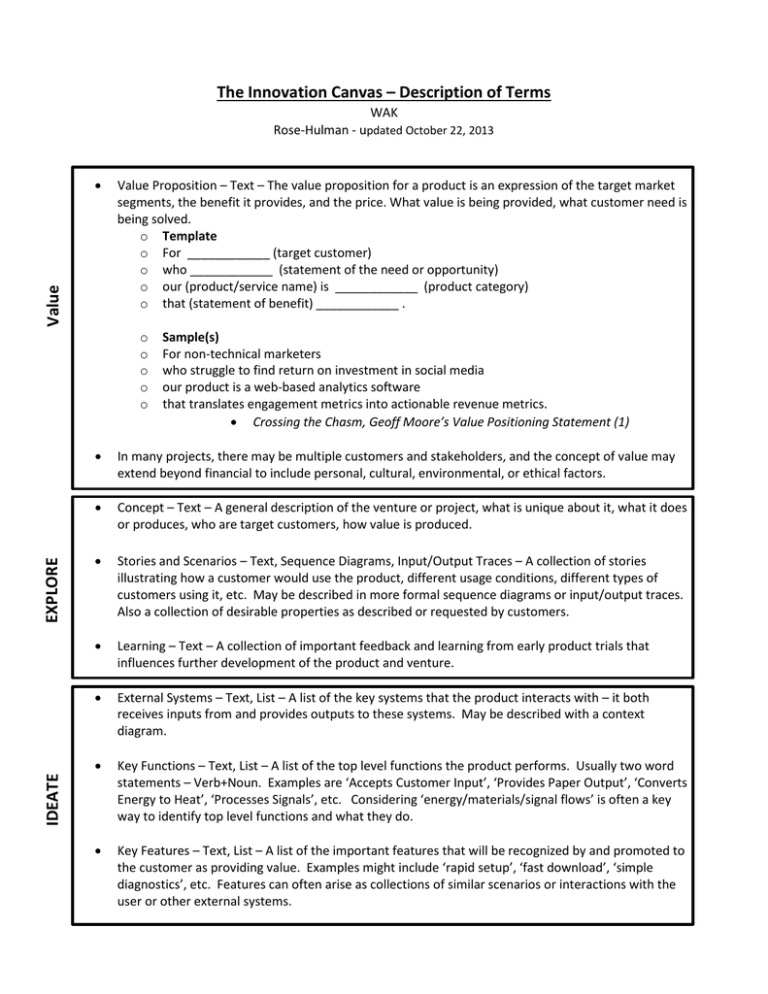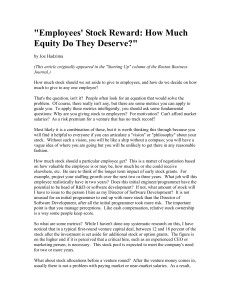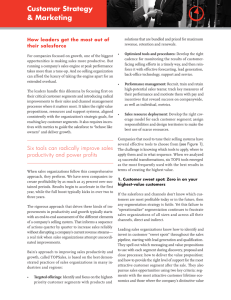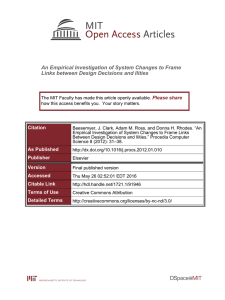The Innovation Canvas – Description of Terms
advertisement

The Innovation Canvas – Description of Terms WAK Rose-Hulman - updated October 22, 2013 Value • Value Proposition – Text – The value proposition for a product is an expression of the target market segments, the benefit it provides, and the price. What value is being provided, what customer need is being solved. o Template o For ____________ (target customer) o who ____________ (statement of the need or opportunity) o our (product/service name) is ____________ (product category) o that (statement of benefit) ____________ . Sample(s) For non-technical marketers who struggle to find return on investment in social media our product is a web-based analytics software that translates engagement metrics into actionable revenue metrics. • Crossing the Chasm, Geoff Moore’s Value Positioning Statement (1) • In many projects, there may be multiple customers and stakeholders, and the concept of value may extend beyond financial to include personal, cultural, environmental, or ethical factors. • Concept – Text – A general description of the venture or project, what is unique about it, what it does or produces, who are target customers, how value is produced. • Stories and Scenarios – Text, Sequence Diagrams, Input/Output Traces – A collection of stories illustrating how a customer would use the product, different usage conditions, different types of customers using it, etc. May be described in more formal sequence diagrams or input/output traces. Also a collection of desirable properties as described or requested by customers. • Learning – Text – A collection of important feedback and learning from early product trials that influences further development of the product and venture. • External Systems – Text, List – A list of the key systems that the product interacts with – it both receives inputs from and provides outputs to these systems. May be described with a context diagram. • Key Functions – Text, List – A list of the top level functions the product performs. Usually two word statements – Verb+Noun. Examples are ‘Accepts Customer Input’, ‘Provides Paper Output’, ‘Converts Energy to Heat’, ‘Processes Signals’, etc. Considering ‘energy/materials/signal flows’ is often a key way to identify top level functions and what they do. • Key Features – Text, List – A list of the important features that will be recognized by and promoted to the customer as providing value. Examples might include ‘rapid setup’, ‘fast download’, ‘simple diagnostics’, etc. Features can often arise as collections of similar scenarios or interactions with the user or other external systems. IDEATE EXPLORE o o o o o DESIGN • Key Components/Modules – Text, List – A list of the top-level physical hardware components that will comprise the product. These components implement the product functions described above. Make vs. buy considerations for each component are identified. Decisions about modularity arise in the mapping of functions to components. In the case of a product line or multiple versions, the product architecture and components included in each version are identified. • Critical to Success – Text, List - A collection of the key factors or measures critical to success of the product. These critical to success factors include performance criteria, constraints, technical metrics, ‘ilities’, or conformance to standards. The technical metrics may come from a needs/metrics analysis. The ilities include: reliability, manufacturability, usability, security, serviceability, interoperability, etc. • Critical Risks – Text, List – The top few risks of product failure that require special attention. The key risks may come from FMEA or other risk studies. MARKET The following themes come from Business Model Generation (2) and additional information can be found in the text. • Revenue Streams – Text, List – The sources of revenue that the venture intends to capture. Examples might include sales, service, or licensing revenues. • Cost Structure - Text, List – The components of cost that the venture is built upon. Examples might include salaries, manufacturing overhead, consultants, licensing fees, etc. • Key Partners – Text, List – A list of the key partners or suppliers to the venture. • Key Activities – Text, List – A list of the key actions that a company must take in order to be successful in offering and maintaining the value proposition. • Key Resources – Text, List – A list of the key resources (physical, financial, intellectual, or human) owned, leased, or acquired by the organization that allow for the creation/maintenance of value. • Customer Segments – Text, List – A list of the key target customer groups described by demographic measures – age, gender, geography, interests, spending habits, desired features, etc. Different customer segments may have expectations for different product features or versions. • Channels – Text, List – A list of the envisioned channels to reach customers – direct sales, online, distribution, etc. Different channels may have expectations for different product features or versions. • Customer Relationships – A list of the type of relationship that each of our segments expects. Citations: 1. 2. http://torgronsund.com/2011/11/29/7-proven-templates-for-creating-value-propositions-that-work/ Osterwalder and Pigneur, Business Model Generation









